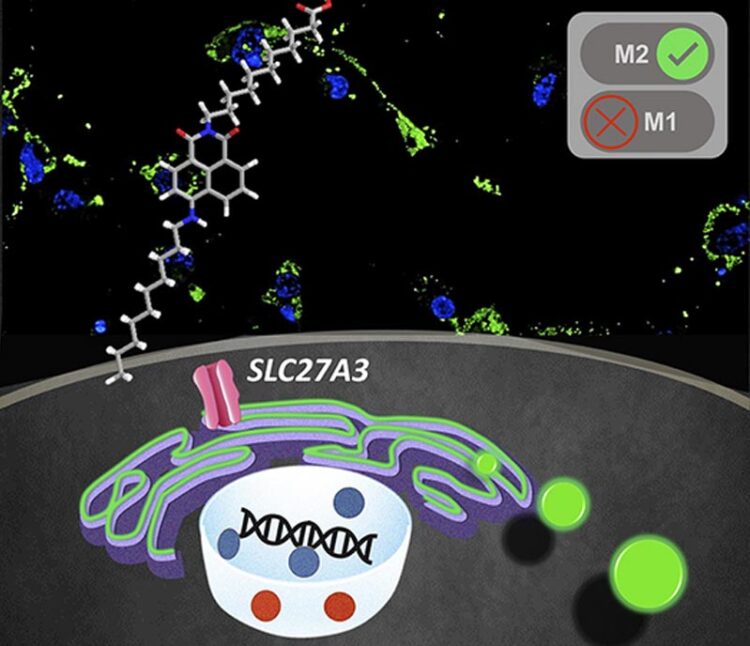Labeling macrophages …

Research Image
Credit: POSTECH
… associated with cancer progression using a selective dye.
M1 and M2 are activated macrophages that protect our immune system and maintain homeostasis. Interestingly, they are characterized by distinct and opposing phenotypes. M1 macrophages are known for their bactericidal and tumoricidal properties by secreting pro-inflammatory cytokines, while M2 macrophages facilitate immunosuppressive responses and help cancer progression.
As such, reprogramming macrophages from M2 to M1 phenotype has been regarded as a significant interest in the view of potential cancer treatment methods. Though it has been challenging to distinguish between living M1 and M2 using fluorescent molecules until now, a research team at POSTECH developed a novel probe, selectively dyeing M2 over M1 for the first time.
The work of the team, comprised of Professor Young-Tae Chang (Department of Chemistry), Professor Nam-Young Kang (Department of Convergence IT Engineering), Professor Haw-Young Kwon, Heewon Cho and Sun Hyeok Lee from the Department of Interdisciplinary Bioscience & Bioengineering at POSTECH, has developed the first M2 selective probe CDg18 with a novel mechanism. The research findings were recently published in the Journal of the American Chemical Society, one of the most renowned journals in the field of chemistry.
Fluorescent probes are chemical compounds that are able to emit light upon recognition of specific ions or materials. The discrimination of living human cells is of importance, not only in clinical diagnosis but the pursuit of effective treatment strategies for infections or inflammatory conditions.
Macrophages are specialized immune cells, exhibiting remarkable plasticity in response to environmental stimuli. The activated macrophages broadly categorize into two different subsets, M1 and M2. M1 macrophages have aggressive functions against invaders such as bacteria and tumors while M2 macrophages are anti-inflammatory cells, which promote tumor immunity.
Tumor-associated macrophages represent a critical determinant to form tumor microenvironment, which is a typical example of M2 cells. Despite the evident importance of M2 macrophages, real-time monitoring of M2 had remained a challenge.
The team developed a novel M2 probe, CDg18, by employing a unique mechanism of Gating-Oriented Live-cell Distinction (GOLD) through the specific overexpressed fatty acid transporter in M2. To demonstrate the potential of CDg18, the team visualized the phenotypic shift of M2 toward M1 using a resveratrol analog HS-1973 as a reprogramming effector.
The simultaneous use of both CDg18 and the M1 probe, CDr17, facilitated dual-color monitoring macrophage reprogramming in real time that was defined by the diminishing M2 character and emergence of M1 markers.
Professor Young-Tae Chang who led the team explained, “The M2 probe (and the M1 probe previously developed) developed by the team in this research enables the monitoring of M1 and M2 distribution in cancerous tissues as well as their changes over time.” He added, “This represents a novel technological approach in addressing the existing limitations in this field.”
This study was sponsored by the Institute for Basic Science, the Ministry of Science and ICT, and the Hyundai Motor Chung Mong-Koo Foundation.
Journal: Journal of the American Chemical Society
DOI: 10.1021/jacs.2c11393
Article Title: Development of a fluorescent probe for M2 macrophages via gating-oriented live-cell distinction
Article Publication Date: 8-Feb-2023
Media Contact
Jinyoung Huh
Pohang University of Science & Technology (POSTECH)
jyhuh@postech.ac.kr
Office: 82-54-279-2415
All latest news from the category: Life Sciences and Chemistry
Articles and reports from the Life Sciences and chemistry area deal with applied and basic research into modern biology, chemistry and human medicine.
Valuable information can be found on a range of life sciences fields including bacteriology, biochemistry, bionics, bioinformatics, biophysics, biotechnology, genetics, geobotany, human biology, marine biology, microbiology, molecular biology, cellular biology, zoology, bioinorganic chemistry, microchemistry and environmental chemistry.
Newest articles

Superradiant atoms could push the boundaries of how precisely time can be measured
Superradiant atoms can help us measure time more precisely than ever. In a new study, researchers from the University of Copenhagen present a new method for measuring the time interval,…

Ion thermoelectric conversion devices for near room temperature
The electrode sheet of the thermoelectric device consists of ionic hydrogel, which is sandwiched between the electrodes to form, and the Prussian blue on the electrode undergoes a redox reaction…

Zap Energy achieves 37-million-degree temperatures in a compact device
New publication reports record electron temperatures for a small-scale, sheared-flow-stabilized Z-pinch fusion device. In the nine decades since humans first produced fusion reactions, only a few fusion technologies have demonstrated…





















